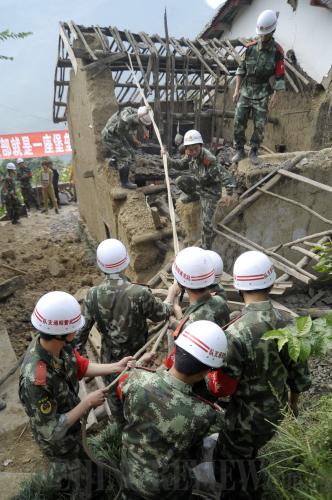|
 |
|
HOUSES IN DANGER: Rescuers tear down the remains of a home in Yiliang County, southwest China's Yunnan Province, after multiple earthquakes hit this area on September 7 (HAO YAXIN) |
The Yunnan lesson
Things in southwest China's Yunnan Province appear to be different.
A 5.7-magnitude earthquake struck Yiliang County in Zhaotong City in Yunnan on September 7, killing 81 people. More than 6,600 houses collapsed and 122,000 were seriously damaged.
"Economic losses reached 3.51 billion yuan ($562 million)," said Su Jingyu, an official with the Ministry of Housing and Urban-Rural Development (MOHURD). "We blamed the earthquake and multiple aftershocks for the damage at first. But it was later found the quake also ruined houses that were allegedly able to withstand magnitude-7 earthquakes."
Su warned this problem does not only exist in Yiliang, but many other rural areas in the country. "The lack of seismic consciousness is the main cause of this," Su said.
In the 20th century, more than 800 earthquakes above magnitude 6 reportedly occurred in China, accounting for 30 percent of the world's total. Since 1949, except for Zhejiang and Guizhou provinces, all provinces and regions on China's mainland have been hit by earthquakes above magnitude 6. Almost all casualties resulted from housing damage.
In 1959, China released a draft standardizing seismic-resistant designs for houses. The 1959 standard was updated in 1964 and 1974, but was never enforced.
After a 7.8-magnitude earthquake hit Tangshan in northern Hebei Province in July 1976 and killed more than 240,000 people, China released its first mandatory standard on seismic design for industrial and civil buildings and put it into practice in 1978. Since then, new buildings in urban areas have been built according to the new standard and old houses are also reinforced accordingly. But rural areas are lagging, according to Ge Xueli, another official with the MOHURD.
After the Tangshan earthquake, each prefecture-level government on China's mainland set up an earthquake emergency management office. But since the mid-1990s, the offices in most provinces and regions have closed down.
"Many people in rural areas build houses in an obsolete way, which leaves potential risks," Ge said. "For example, some residents in the east and south of China prefer cavity walls, which will suffer serious damage even in small earthquakes. The same is true of the earth-walled houses in northwestern regions."
"As earthquake forecasting is still unattainable with current technology, moving people into anti-seismic houses is the best way to reduce casualties," said Mao Yulin, Secretary General of Beijing-based Mao Yisheng Science and Technology Education Foundation.
Mao believes the experience of Xinjiang can spread to other parts of China.
On average, under current consumption standards, Mao said that the renovation subsidy for each recipient household can be set at 5,000 yuan ($794).
"Now we have approximately 800 million rural residents, roughly 200 million households, so the total investment can reach 1 trillion yuan ($160 billion)," Mao said. "The whole project may take about 10 to 20 years to complete, that is to say, every year the government needs to invest 50-100 billion yuan ($8-16 billion). Compared to the 1.7 trillion yuan ($272 billion) the country put into reconstruction after the magnitude-8 Wenchuan earthquake hit Sichuan in May 2008, this is a small amount of money."
Ge agrees with Mao, saying that many rural houses were not built up to standard and many houses function merely to block wind and rain.
"We should put more effort into prevention to ensure the safety of residents. The huge losses from the Yiliang earthquake show we didn't do a good job to begin with."
Email us at: yuanyuan@bjreview.com | 